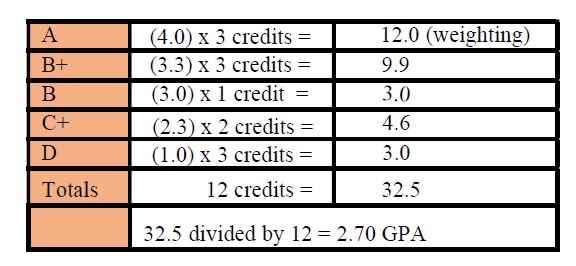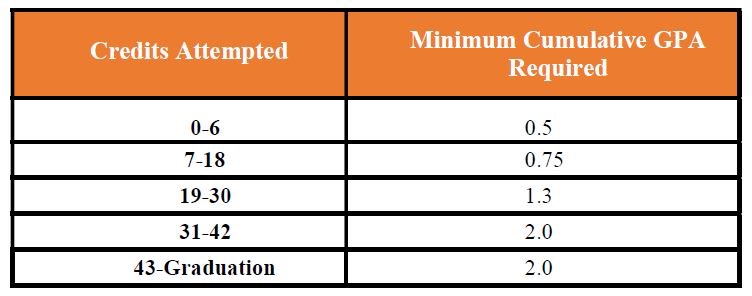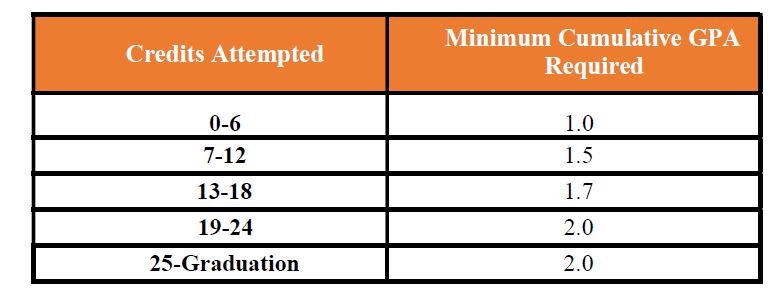SATISFACTORY ACADEMIC PROGRESS
LIBI has established basic standards to define Satisfactory Academic Progress for all students and the terms of academic probation, academic dismissal, extended enrollment status, academic warning, and graduation. These are expectations of academic performance that increase gradually as the student approaches completion. Graduation requires a minimum cumulative Grade Point Average (GPA) of 2.0 (C). Some programs require a higher cumulative GPA for graduation. Additional requirements exist for students using federal and state financial aid. These will be further explained in later sections. Please note that satisfactory academic progress is reviewed to determine student academic status (such as academic warning, academic probation, and academic dismissal), Federal Financial Aid and New York State Tuition Assistance Program (TAP) eligibility.
 *An incomplete (I) grade is awarded only when the student is able to pass the course by completing work or onsibility to make arrangements with their instructors to complete any missed work. The (I) grade must convert to a passing grade within the first ten school days (not including weekends and holidays) of the following semester; otherwise, it will automatically become an F, computed as 0.0 in the Grade Point Average and will be reflected on the student’s transcript.
*An incomplete (I) grade is awarded only when the student is able to pass the course by completing work or onsibility to make arrangements with their instructors to complete any missed work. The (I) grade must convert to a passing grade within the first ten school days (not including weekends and holidays) of the following semester; otherwise, it will automatically become an F, computed as 0.0 in the Grade Point Average and will be reflected on the student’s transcript.
**For Court Reporting speedbuilding courses, the grade of IP (In Progress) will be assigned at the end of the semester if a student has not achieved the course required exit speed or met other exit criteria of a Court Reporting Program. The IP grade will stay on the student transcript permanently and be computed as 0.0 in the Grade Point Average. The student will be placed on Academic Warning. The student must enroll in the same speedbuilding course in the next registered semester. Students on Academic Warning will be required to meet with their Faculty Advisors regularly throughout the semester to ensure satisfactory academic progress. If the student fails to achieve a passing grade while on Academic Warning, the student will be placed on Probation and receive a grade of F and will be ineligible to receive financial aid. The terms of Probation will be discussed with each student individually by the designated Senior College Administrator. Additional academic assignments may be required to ensure the student’s return to satisfactory academic progress. Students who do not successfully complete the course while on Probation will be dismissed, will lose matriculated status, and receive an F in the course. For more information, refer to Appendix C of the College catalog. Students who are placed on Academic Warning or Probation more than once, must be counseled by their Programs Director/Faculty Advisor and the Financial Aid Director/Specialist regarding the possibility of exceeding the 150% maximum time frame.
***The grade of W (Withdraw) is assigned if a student takes a Leave of Absence, withdraws from the institution, or drops a class prior to the beginning of the 12th week of classes in a semester. The W grade is computed as credits attempted but is not averaged into the GPA. From the 12th week onward, regular grades will be assigned by the student’s instructors. A student may request consideration for W grades after the 12th week by writing to the Exceptions Committee. The request should be based on extenuating circumstances.
****The grade of UW (Unofficial Withdraw) is assigned to students who began attendance but ceased participation in academic related activities after the 60% point of the semester. This grade is computed as credits attempted, and has the same effect as an F (Failure) grade on GPA.
*****A former or current student can request to audit a Court Reporting course with the Registrar if the student has previously completed and passed the same course or an equivalent course. Audited courses do not qualify for financial aid. The student will earn a grade of AU upon completion of the course. The AU grade has no effect on attempted credits, GPA, and satisfactory academic progress.
******The grade of NS (No Show) is assigned when an enrolled student did not begin attendance in a class. This grade is computed as credits attempted and they have the same effect as an F (Failure) grade on GPA. It may also change the enrollment status of a student and may have an impact on student visa status.
Any required course with an F, R, IP, W, UW and NS grade must be repeated. The new grade replaces the old in the Grade Point Average calculation and the F will remain on the transcript.
ESL CERTIFICATE PROGRAM ATTENDANCE REQUIREMENTS
For students enrolled in the ESL Certificate program, they need to attend 90% of classes based on a 360-hour semester in order to be eligible for Federal financial aid in the following term of enrollment.
GRADE GRIEVANCE
For detailed information about grade grievance, please refer to the Student Handbook.
CREDITS ATTEMPTED
Credits attempted are computed for all courses applicable to student’s current program of study for which the student has received a final grade or has withdrawn with tuition liability or has been granted credits for study outside of LIBI. Credits earned by CLEP and Proficiency Exams are not considered attempted credits but are counted toward the maximum time frame. Withdrawal (W) grades are computed as attempted but they have no effect on GPA. No Show (NS) grades and Unofficial Withdraw grades (UW) are computed as attempted, and they have the same effect as an F (Failure) grade on GPA. Incomplete (I) courses are not computed as attempted until a final grade is achieved, but the grade must be secured within the first ten school days (not including weekends and holidays) of a semester or it converts to an F. Courses in which the In Progress (IP) is assigned are computed as attempted. Any student who receives an IP grade is automatically placed on Academic Warning. The student must retake the course and earn a passing letter grade in the next registered semester to meet the terms of satisfactory academic standing.
* Transfer credits are counted towards both attempted credits and earned credits.
REPEATING COURSES
All withdrawals and grades of F in required courses must be repeated, and the new grade replaces the F in the calculation of the Grade Point Average. The additional attempted credits are used in calculating Satisfactory Academic Progress. The original F grade will appear on the transcript. Students who fail the same course two times will be placed on Academic Probation and Financial Aid Warning. Failed/where an F is given in a course may be repeated twice and will be placed on Academic Probation. Repeating the same course for the third time, with a grade of F will result in an Academic Dismissal and lose of Federal and State Financial Aid. Students who fail one credit courses that are no longer offered by the college will be given an AE course as of September 2019. Students who fail two out of the three classes from the Freshman cluster must take the First Year Seminar as of September 2019.
* No Federal and State Financial Aid will be awarded for repeating courses with passing grades.
FINANCIAL AID WARNING
Financial Aid status that the college assigns to a student who is failing to make satisfactory academic progress. The status is assigned without the need of appeal, during which the student may continue to receive Federal Financial Aid for the following semester. However, if the student fails to meet satisfactory academic progress at the end of the following semester, Federal Financial Aid will cease for future semesters unless the student reestablishes eligibility by meeting satisfactory academic progress during extended enrollment status (non-matric) semester(s) without Federal and State Financial Aid.
GRADE POINT AVERAGE
At the end of each semester, Grade Point Averages (GPAs) are computed for all students. The GPA is a numerical record that is used to evaluate Satisfactory Academic Progress (SAP) and determine eligibility for courses in the following semester. Additionally, the GPA is used to determine graduation eligibility, graduation honors, inclusion in the Alpha Beta Kappa, Sword and Shield and The National Technical Honor Societies, probation, and suspension. The GPA is also used to determine continued eligibility for various financial aid programs. Students will receive a transcript with grades and GPA computed. GPA computation is weighted based upon credits. If you multiply the grade in a course by the number of credits in a course, you arrive at the weighting (also referred to as quality points). Add all the weightings together and divide by the number of credits to get the GPA.
For example:
List all the courses taken at LIBI and the grade earned in each one. Using the chart below, write the numerical value for each grade. Next, figure out the number of credits assigned to each course. Multiply the balue by the number credits for each course. This calculation gives the “weighting” or the “quality points” column. Take the total number of credits and divide them into the total number of quality points to reach your correct GPA.

SATISFACTORY ACADEMIC PROGRESS FOR PURPOSES OF FEDERAL FINANCIAL AID GPA REQUIREMENTS
Students not meeting the GPA benchmarks listed below will be placed on Financial Aid Warning for one semester. Federal financial aid can be used for the next enrollment term to assist students in their effort to return to good standing.
For non-remedial students who enroll in A.O.S. degree and Court Reporting Certificate programs:

For remedial students who enroll in A.O.S. degree and Court Reporting Certificate programs:

The standards for all other certificate programs:

In addition, students need to achieve a minimum cumulative GPA. of 2.0 after four semesters of study. If students cannot achieve the required GPA, they will be placed on Financial Aid Warning. Failure to achieve the needed benchmark by the end of the next semester of study will result in loss of Federal Financial Aid.
For example,
If a non-remedial student attempted 35 credits and earned 35 credits with a GPA of 1.99 after third semester of study, he/she is making satisfactory academic progress. However, if the same were met after fourth semester, the student will be placed on Financial Aid warning due to not earning a minimum cumulative GPA of 2.0 after four semesters of study.
PURSUIT OF PROGRAM REQUIREMENTS
In addition to achieving academic progress in terms of grades, students must be pursuing graduation at an acceptable pace in order to qualify for federal financial aid. Students must progress with sufficient pace to complete the program within 150% of the normal length of the program. To make adequate progress towards this 150% requirement, a student will have to pursue the program according to the following benchmarks, with credits attempted defined as in the previous section:

Pursuit of program progress is computed at the conclusion of each academic semester. Failure to attain the minimum pursuit of program percentage places the student on Financial Aid Warning for one semester, federal financial aid eligibility continues. Failure to achieve the needed benchmark by the end of the next semester of study will result in loss of Federal Financial Aid.
For Example,
If a student was enrolled in 61-credit A.O.S. program, the maximum credit attempt based on 150% is 91 credits. After he/she reaches 22 credits (91*25%) attempted, the student needs to earn at least 11 credits (50% of 22 credits attempt) in order to meet satisfactory academic progress. If the student only earned 10 credits at that check mark, he/she will be placed on Financial Aid warning.
SATISFACTORY ACADEMIC PROGRESS FOR ALL NEW YORK STATE TAP GRANT RECIPIENTS
In addition to meeting the requirements for Title IV satisfactory progress, students must also meet standards of satisfactory academic progress and pursuit for state aid programs. There are three elements of satisfactory academic progress that all financial aid recipients must meet in order to be eligible for financial aid from the New York State sponsored Tuition Assistance Program (TAP).
- Students must accrue a specific number of credits based upon the total number of TAP payments received.
- Students must achieve a minimum grade point average based on the total number of TAP payments received.
- The regulations define pursuit of program as receiving a passing or failing grade in a certain percentage of a full-time course load. The percentage increases from 50% of the minimum full-time load in each term of study in the first year for which an award is made, to 75% of the minimum full-time load in each term of study in the second year for which an award is made, to 100% of the minimum full-time load in each term of study in the third and each succeeding year for which an award is made. Accepted grades of passing or failing are A through F. A grade of PS, indicating that a student has successfully completed a developmental non-credit course, would be acceptable.
Grades of IP (In Progress) would only be acceptable if automatically changed to a standard passing or failing grade before the completion of the next term of study. Grades of W (Withdrawal) do not constitute grades which indicate that the student passed, failed, or completed all work in a course and cannot be counted toward meeting the pursuit of program requirement.
STANDARD OF SATISFACTORY ACADEMIC PROGRESS FOR PURPOSES OF DETERMINING ELIGIBILITY FOR NEW YORK STATE STUDENT AID
PROGRAM: ASSOCIATE DEGREES AND COURT REPORTING CERTIFICATE TRIMESTER BASED PROGRAM CHART – APPLIES TO NON-REMEDIAL STUDENTS FIRST RECEIVING AID IN 2010-11 AND THEREAFTER.

PROGRAM: ASSOCIATE DEGREES AND NON-ESL CERTIFICATE SEMESTER BASED PROGRAM CHART – APPLIES TO NON-REMEDIAL STUDENTS FIRST RECEIVING AID IN 2010-11 AND THEREAFTER.

PROGRAM: ASSOCIATE DEGREES AND COURT REPORTING CERTIFICATE TRIMESTER BASED PROGRAM CHART (2006 STANDARDS) – APPLIES TO STUDENTS FIRST RECEIVING AID IN 2007-08 THROUGH AND INCLUDING 2009-10 AND REMEDIAL STUDENTS FIRST RECEIVING AID IN 2007-08 AND THEREAFTER.

PROGRAM: ASSOCIATE DEGREES AND NON-ESL CERTIFICATE SEMESTER BASED PROGRAM CHART (2006 STANDARDS) – APPLIES TO STUDENTS FIRST RECEIVING AID IN 2007-08 THROUGH AND INCLUDING 2009-10 AND REMEDIAL STUDENTS FIRST RECEIVING AID IN 2007-08 AND THEREAFTER.
 NOTE: STUDENTS ENROLLED IN A TWO-YEAR PROGRAM CANNOT RECEIVE MORE THAN THREE (3) YEARS OF TAP (6 AWARDS).
NOTE: STUDENTS ENROLLED IN A TWO-YEAR PROGRAM CANNOT RECEIVE MORE THAN THREE (3) YEARS OF TAP (6 AWARDS).
Students transferring credit, whether from another school or as a result of change of program, will have their SAP determined by the number of credits completed in pursuit of the certificate or degree at the time of admission. If a student who is in good academic standing changes programs, only the credits applicable to the new program requirements are counted in determining whether the student meets the credit accrual and cumulative grade point average requirements for satisfactory academic progress for financial aid purposes.
ONE-TIME WAIVER
A one-time waiver may be granted to a TAP recipient who fails to meet pursuit of program or satisfactory academic progress requirements. Students must initiate the request for a TAP waiver and must be able to document there are extraordinary or unusual circumstances beyond the control of the student. The approval of the waiver request is not automatic. After a careful review of the documentation provided by the student, the student will be notified in writing if the one-time waiver will be granted.
C AVERAGE WAIVER
The C average requirement may be waived for undue hardship based on:
- Death of a relative of the student;
- Personal injury or illness of the student;
- or Other extenuating circumstances.
If warranted, a C average waiver may be granted more than once with proper documentation.
